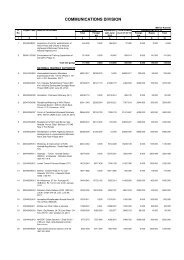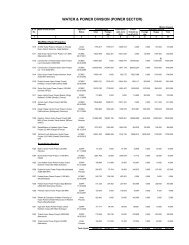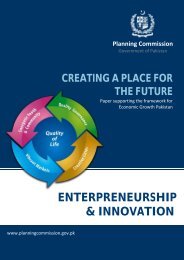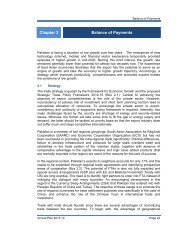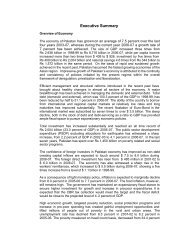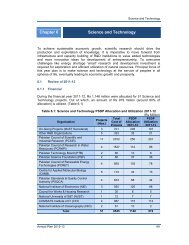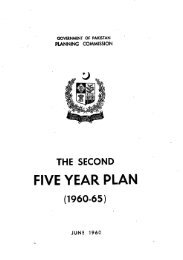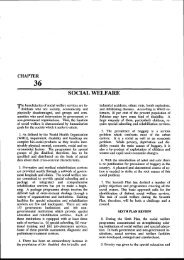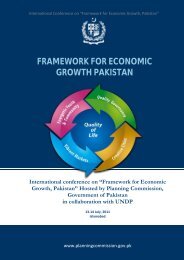Physical Planning and Housing
Physical Planning and Housing
Physical Planning and Housing
- No tags were found...
You also want an ePaper? Increase the reach of your titles
YUMPU automatically turns print PDFs into web optimized ePapers that Google loves.
<strong>Physical</strong> <strong>Planning</strong> <strong>and</strong> <strong>Housing</strong>To achieve a tangible progress in PP&H sector, the issues, which are being persuadedin the current fiscal year 2008-09, are:• Development of Federal Capital Islamabad.• Improvement in the management of civic services in urban areas as well asrural areas.• Control of further growth in bigger cities by diverting the populationmigration from natural areas to medium-size towns.• Narrowing gap between the housing dem<strong>and</strong> <strong>and</strong> supply.• Provision of water supply <strong>and</strong> sanitation services to maximum population.• Regularization <strong>and</strong> improvement of Katchi Abadis <strong>and</strong> slums.• Encouragement of private sector for investment in housing.• Research <strong>and</strong> development in the field of indigenous constructiontechnology.Urban DevelopmentCurrently, over one-third of the country’s population about 56 million people live inurban areas. By 2030, Pakistan will become predominantly urban with challenge ofmanaging additional 70-80 million more city dwellers. Mega cities like Karachi <strong>and</strong>Lahore will operate under a new set of economic dynamics, as both are ranked lowaccording to City Development Index. This will dem<strong>and</strong> a holistic approach to addressthe issues of increasing rural non-farm employment, rural-urban complementarities,<strong>and</strong> the needs to develop balanced hierarchies of settlements. Various measures toimprove urban development are presented in Box 7.1Box 7.1 Measures to Improve Urban Development• Implement National Spatial Strategy, with spatial development action plans at,provincial, district <strong>and</strong> tehsil level.• Diversify the economic base of smaller towns by establishing resource basedindustries based on potentials of the area.• Develop sustainable devolved institutional mechanism up to small town’s levelthrough close community participation to carry out planned activities effectively.• Undertake metropolitan economic planning across entire urban regions enablingall stakeholders to formulate comprehensive development plans <strong>and</strong> carry out acoordinated set of targeted investments, to link cities with rural suburbs.• Encourage Private sector investment through public–private partnerships <strong>and</strong>innovative modes of development with incentives.• Minimize congestion & environmental hazards in large cities, by promotingurbanization of rural settlements <strong>and</strong> establishment of new towns alongmotorways / highways, <strong>and</strong> new satellite towns around metropolitan areas.Annual Plan 2009-10 110
<strong>Physical</strong> <strong>Planning</strong> <strong>and</strong> <strong>Housing</strong>including Rawalpindi & Islamabad. The Workers Welfare Fund undertook five projectsfor construction of flats for workers near industrial estates at provincial capitals.To cater for acute shortage of government office buildings especially in Islamabad, theMinistries /Departments/Agencies continued construction of respective office buildings.Main / Programs Achievements During 2008-09<strong>Housing</strong> for AllWater Supply &SanitationDue to financial crunch only 50% of the targets wereachieved, during the plan period.Due to financial crunch only 50% of the targets wereachieved, during the plan period.(Population Coverage)i) Urban WaterSupply87%ii)iii)iv)Urban SanitationRural WaterSupplyRural Sanitation66%58%33%Katchi Abadis / SlumImprovement(Population Coverage)Due to financial crunch only 50% of the targets wereachieved.About 0.15 million additional population’s environmentalcondition has been improved in Katchi Abadis /Slumsthrough out the country.Annual Plan 2009-10 112
<strong>Physical</strong> <strong>Planning</strong> <strong>and</strong> <strong>Housing</strong>Programs for 2009-10The following activities will be undertaken during 2009-10.• Emphasis will be given on implementation of Prime Minister’s one millionhousing for low income groups along with one million housing units onownership basis.• At Federal level, through PSDP a large number of official accommodationprojects pertaining to Civil Armed Forces (CAF)/Police/Judiciary, <strong>and</strong>essential government offices, urban development, housing accommodation,<strong>and</strong> water supply <strong>and</strong> sewerage will be undertaken.• The Federal Government under matching grants between federal <strong>and</strong>provincial governments will continue to provide support for bulk watersupply & sewerage projects in Karachi, Hyderabad, Mirpurkhas,Nawabshah, Sukkur, Quetta, Faisalabad, Okara, Peshawar, Malak<strong>and</strong>,Muzaffergrah, Muzzaffarabad <strong>and</strong> other cities including coastal areas,urban areas uplifts projects in Ziarat, Loralai, Kohlu <strong>and</strong> Gwader.• The PSDP would continue financing water supply & sewerage schemes inlCT <strong>and</strong> construction of functional buildings/ structures <strong>and</strong> residentialaccommodations. The CDA will be focusing on development of roads /highways / overhead bridges / pedestrian bridges <strong>and</strong> continuedevelopment of residential sectors <strong>and</strong> to provide plots for construction ofhouses to reduce acute shelter problem in the federal capital.• Federal government will continue <strong>and</strong> expedite to provide houses to federalgovernment employees on ownership basis on their retirement.• For efficient delivery of water supply & sewerage services in urban areasefforts will be made to complete the on-going schemes <strong>and</strong> to recover thefull O&M costs; to initiate a phased program of rehabilitating the old watersupply <strong>and</strong> sewerage network; to reduce the water losses; <strong>and</strong> to integratethe planning <strong>and</strong> development of new water <strong>and</strong> sewerage projects.• To expedite improvement of katchi abadis /slums, the district governmentswill be activated to ensure participation of end-users in identifying problems<strong>and</strong> in setting their own proprieties, district governments <strong>and</strong> urb<strong>and</strong>evelopment of respective areas/ cities.Urban DevelopmentDuring 2009-10, draft National Spatial Strategy will be finalized within the framework ofVision 2030 to safeguard the areas of national interest <strong>and</strong> provide guidelines aimed atmaximizing efficiency of human settlements. The current urban centers, which arealready congested <strong>and</strong> polluted, would not be able to absorb the envisaged enhancedeconomic activities <strong>and</strong> trade. Accordingly, as part of the National Spatial Strategy, it isenvisaged to diversify the growth of population <strong>and</strong> urbanization through out thecountry.The National Spatial Plans will be linked to provincial <strong>and</strong> local plans within a longtermregional planning framework to connect cities with the rural suburbs through theprovision of facilities, amenities <strong>and</strong> other infrastructure <strong>and</strong> services. This willenhance the thrust towards rural urbanization to minimize the congestion, pollution <strong>and</strong>Annual Plan 2009-10 113
<strong>Physical</strong> <strong>Planning</strong> <strong>and</strong> <strong>Housing</strong>other typical environmental hazards in large cities. Characteristics of the cities asengine of growth are presented in Box 7.2.A National Trade Corridor (NTC) improvement program has already been launched<strong>and</strong> in progress. The Corridor will be linked with establishment of new cities; logisticcenters (for retail <strong>and</strong> wholesale trade); special economic zones, industrial <strong>and</strong>technology parks; <strong>and</strong> cold chain/food processing centers. During 2009-10, theplanning of new cities will commence in conjunction with economic activities along themotorways <strong>and</strong> expressways. A program of upgrading of infrastructure within theexisting urban centers <strong>and</strong> existing intercity networks will also be undertaken.Box 7.2 Cities as Engine of GrowthCities are increasingly becoming engines of growth, centers of economic activity,knowledge.It is planned to develop cities as hubs of trade <strong>and</strong> commerce with higher levels <strong>and</strong>intensities of infrastructure <strong>and</strong> connectivity to the outer world compared to thepresent.The functioning of the mega <strong>and</strong> large cities will be improved through metropolitaneconomic planning across the entire urban region, bringing together the national,provincial <strong>and</strong> local government agencies, business <strong>and</strong> community leadership toformulate comprehensive plans <strong>and</strong> carryout coordinated targeted investments.Among other things, investments in urban regions including the centers will beenhanced through public-private partnerships <strong>and</strong> other innovative modes. This willfacilitate private sector involvement in value added services <strong>and</strong> products, <strong>and</strong>promote industrialization with intensified marketing <strong>and</strong> financial mechanisms. Afocus will be the provision of local infrastructure including roads, clean drinkingwater, sanitation, basic health <strong>and</strong> education <strong>and</strong> electricity to enhance the qualityof life of the residents.Urban GovernanceMajor initiatives will be undertaken to improve the infrastructure relating to movement ofgoods <strong>and</strong> people. A holistic <strong>and</strong> multi-nodal approach will be initiated, which will resultin a quantum increase in the scale <strong>and</strong> quality of urban infrastructure. Besides, therecent innovation in governance is likely to affect the future of cities in Pakistan.Municipal finance has emerged as a core issues in the functioning of cites, whichrequire an increasing proportion of monetary, material <strong>and</strong> human resources to fulfillcivic aspirations. During 2009-10, new approaches would be explored to facilitate thefinancing of major infrastructure in large cities including financing in part by profitsgenerated by property development. An entrepreneurial approach, with involvement ofthe private sector, will be adopted on a citywide basis to promote metropolitan cities topotential investors. Accessing the capital markets through municipal or other bondissues, with or without government guarantee, would also need to be considered. Thiswould be complemented by price reforms to meet the cost of efficient serviceprovision, manage dem<strong>and</strong> <strong>and</strong> generate cash to catalyze new investments.Water Supply <strong>and</strong> SanitationThe development of urban water supply would be based on meeting rapidly increasingdem<strong>and</strong> for household <strong>and</strong> industrial water, increasing investments in new waterAnnual Plan 2009-10 114
<strong>Physical</strong> <strong>Planning</strong> <strong>and</strong> <strong>Housing</strong>national statutory framework would be developed as a starting point forcontract negotiations <strong>and</strong> must cover factors such as minimum qualityst<strong>and</strong>ards <strong>and</strong> environmental parameters.• Regulatory framework at local level to address the quality, price, <strong>and</strong>required reliability of the service; the investment program; maintenance ofassets; <strong>and</strong> rights of access in the public domain. The skills of RiskAssessment to create an environment conducive to attracting the privatesector, <strong>and</strong> Forging Agreements with private service providers, also need tobe developed.The major PP&H sectoral programs to be implemented during 2009-10, are highlightedbelow:Sub-Sector PP&H Targets 2009-10• Prime Minister’s One Million <strong>Housing</strong> Programme for low income groups (Poor &low paid government employees)• Development of Residential PlotsTo facilitate development of 2,50,00 small each size residential plots in “site & ServicesSchemes” in urban <strong>and</strong> rural areas, for construction of houses by the allottees.• Water Supply / Sanitation / Seweragei) Urban Water SupplyIncrease population coverage from present 87 per cent to 89 percent.ii)iii)iv)Urban Sewerage & Sanitary DrainsIncrease population coverage from present 66 per cent to 68 percent.Rural Water SupplyIncrease population coverage from present 58 per cent to 60 percent.Rural SanitationIncrease population coverage from present 33 per cent to 35 percent.• Katchi Abadis Slums Up-gradationImprovement of environmental conditions of additional 0.250 million population in Katchi Abadis /Slums.• Government Employees <strong>Housing</strong>Provision of addition 2000 houses <strong>and</strong> flats from Government Employees in Islamabad &Provincial Capitals.• Government Offices & BuildingsConstruction of 0.20 million square feet covered area for federal / provincial governmentagencies & Civil Armed Forces.• <strong>Housing</strong> for Industrial WorkersConstruction of 1000 small size plots <strong>and</strong> houses / flats, by the Workers Welfare Fund.• Houses for Overseas PakistanisImplementation of on-going schemes in major cities by the Overseas PakistanisFoundationAnnual Plan 2009-10 116




